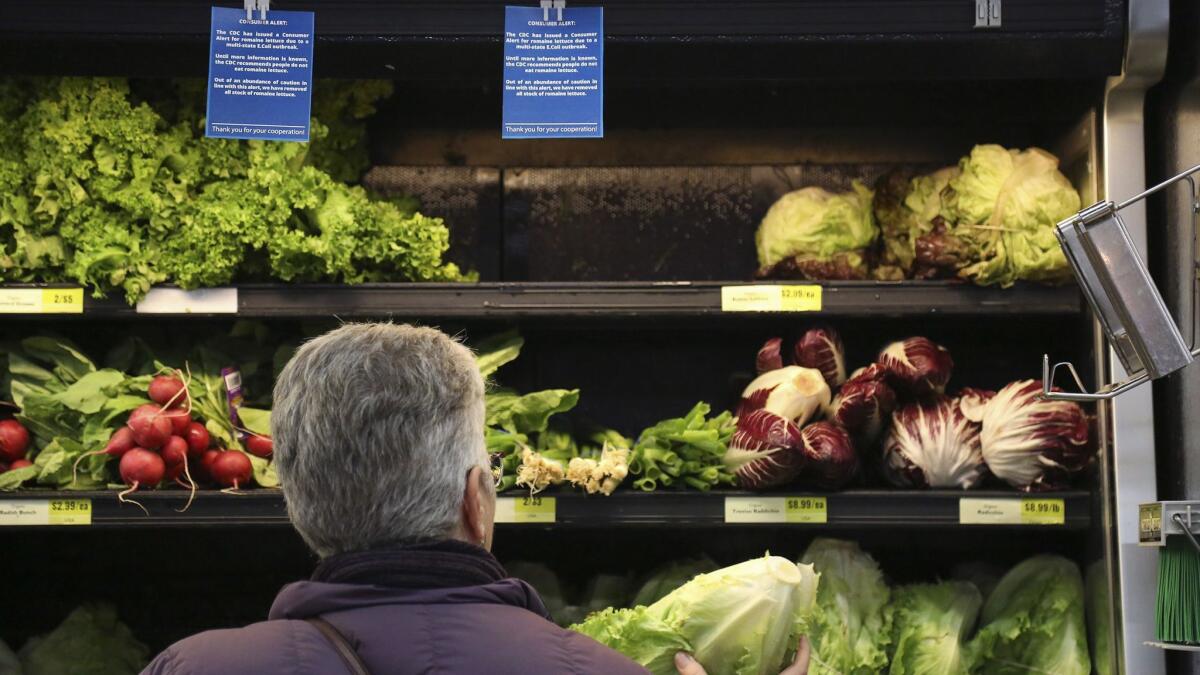Only romaine lettuce from parts of California should be avoided, FDA says in new warning

- Share via
Federal health officials said Monday that only romaine lettuce from certain parts of California is unsafe to eat and romaine lettuce entering the market will now be labeled to give consumers information about when and where it was harvested.
If consumers, retailers and food service facilities can’t determine whether the romaine was grown outside California, they should not eat it and should throw it away, even if some of it was eaten and no one got sick, according to a lengthy statement from Food and Drug Commissioner Scott Gottlieb on Monday.
FDA officials said the most likely source of contamination is from the Central Coastal growing regions in Northern and Central California. Romaine lettuce harvested outside of those regions “does not appear to be related to the current outbreak,” the FDA said. Hydroponically- and greenhouse-grown romaine also does not appear to be affected in the outbreak. Romaine from these sources is safe to eat, the FDA said.
No common grower, supplier, distributor or brand of romaine lettuce has been identified in the outbreak. Several major romaine lettuce producers have agreed to label products with a harvest date by region, and new romaine from different growing regions, including Florida and Arizona, is being restocked in grocery shelves.
The new warning from the Food and Drug Administration and the Centers for Disease Control and Prevention came as the number of people sickened by the outbreak grew to 43 people in 12 states.
The updated information follows an unusually broad warning that federal health officials issued two days before Thanksgiving, telling consumers to throw away any romaine lettuce they already may have purchased. At the time of the outbreak, the majority of romaine on the market was being grown in the Central Coast region of California. Since then, harvesting of romaine has ended and shifted to the winter growing regions, which include the California desert region of the Imperial Valley, the desert region of Arizona in and around Yuma, and Florida, Gottlieb’s statement said.
“Romaine lettuce that was harvested outside of the Central Coast growing regions of Northern and Central California does not appear to be related to the current outbreak,” he said. Hydroponically- and greenhouse-grown romaine also does not appear to be related to the outbreak, he said. “There is no recommendation for consumers or retailers to avoid using romaine harvested from these sources.”
Investigators have been tracing the romaine eaten by people sickened in the outbreak. U.S. officials are also coordinating with the Public Health Agency in Canada, which is also investigating a similar outbreak. The Canadian agency reported 22 confirmed cases in three provinces: Ontario, Quebec and New Brunswick.
E. coli are bacteria that live naturally in the intestines of cattle, poultry and other animals. The bacteria can contaminate a wide variety of agricultural products through contact with feces from infected animals. Most E. coli strains are harmless to humans, but some varieties can cause severe illness.
Five people died in the most recent major outbreak from contaminated romaine, which lasted from March to June of this year and led to 210 cases in 36 states. That outbreak was traced to the Yuma, Ariz., growing region, but investigators never conclusively determined the precise source. FDA’s Gottlieb has said the leading suspect is contaminated canal water used by multiple farms.
Illnesses in the current outbreak started in October, and it is not related to the Yuma outbreak. The strain in this one has the same genetic fingerprint as the one that caused illnesses late last year in both the United States and Canada. Canada linked its cases to romaine lettuce specifically, but U.S. investigators said only that the origin was in leafy greens. That outbreak was declared over in January. The precise origin was never determined.
All three outbreaks — the current one, the one from Yuma and the one from last year — are caused by contamination of an E. coli strain known as O157:H7. It produces a Shiga toxin that in severe cases can lead to hemolytic uremic syndrome, a type of kidney failure.
Sun writes for the Washington Post.
More to Read
Inside the business of entertainment
The Wide Shot brings you news, analysis and insights on everything from streaming wars to production — and what it all means for the future.
You may occasionally receive promotional content from the Los Angeles Times.








